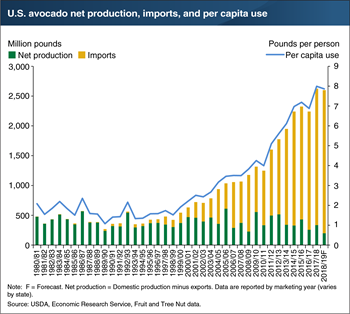
Posts Tagged: forecasting
USDA Forecasts for Avocado And Citrus and .....
Here's an example of the kind of information that can be both exciting and disappointing - forecasts of the future of the citrus and avocado industries and many other fruit and nut crops. The latest forecasts are available form the USDA - Economic Research Service:
https://www.ers.usda.gov/webdocs/publications/92731/fts-368.pdf?v=7239.3

Wednesday, April 24, 2019
Imports play a significant role in meeting the U.S. demand for avocados. Since the mid-1990s, imports of avocados have grown sharply as per capita consumption has grown, representing 87 percent of domestic use in the 2017/18 marketing year. USDA forecasts that imports will make up an even larger share of supply in 2018/19, mainly because California's crop is expected to be smaller than in recent years. Contributing factors to this reduced crop include record-breaking heatwaves in July 2018 followed by record-breaking wildfires, as well as recent rains and cold weather, and the general alternate-year-bearing nature of avocado trees (whereby a large crop one year is followed by a smaller crop the next year). Because over 80 percent of all U.S.-produced avocados each year are from California, California's low harvest in 2018/19 should boost U.S. demand for imported avocados (especially from Mexico) even higher than it has been in recent years. If USDA's forecast is realized, imports in 2018/19 will represent 93 percent of the domestic avocado supply. This chart appears in the ERS Fruit and Tree Nuts Outlook newsletter, released in March 2019.
Fruit & Tree Nuts
Provides current intelligence and forecasts the effects of changing conditions in the U.S. fruit and tree nuts sector. Topics include production, consumption, shipments, trade, prices received, and more.
https://www.ers.usda.gov/webdocs/publications/92731/fts-368.pdf?v=7239.3
Can the past foretell the future?

avocado grower 1910
Weather Tracker
Reno, NV (Sept 10, 2018): Scientists from the Western Regional Climate Center (WRCC) at the Desert Research Institute (DRI) in Reno, Nev. are pleased to announce the release of a long-awaited update to a climate mapping tool called the California Climate Tracker.
"One really significant change between the old and new versions of the California Climate Tracker is that in the previous version, you weren't able to look at archived maps," said Daniel McEvoy, Ph.D., Assistant Research Professor of Climatology at DRI and member of the Climate Tracker project team. "Now you can say for example, 'I want to see what the 1934 drought looked like,' and go back and get the actual maps and data from 1934. You can also look at graphs of the data and see trends in temperature and precipitation over time."
In addition to providing historical and modern data for regions across California, this easy-to-use web-based tool can be used to produce publication-quality graphics for reports, articles, presentations or other needs. It can be accessed for free by anyone with a standard web browser and an internet connection.
"The California Climate Tracker was initially designed and developed for use by the California Department of Water Resources, but we hope it is also useful to a much broader community of water managers, climatologists, meteorologists and researchers in California," McEvoy said.
Read more at: https://phys.org/news/2018-09-california-climate-tracker-tool-years.html#jCp

rainfall forecast CA
Rain ???? Weather Forecasting Failure
Last Sunday was forecast as 20% chance of rain in Ventura, but it didn't happen. Today, Friday it was supposed to rain, but it's barely a drizzle. My car's dust has just been redistributed. Could a better prediction be forecast? According to Cliff Mass it certainly could.
http://cliffmass.blogspot.com/
http://www.nytimes.com/2016/10/23/magazine/why-isnt-the-us-better-at-predicting-extreme-weather.html
According to Mass, other countries like the UK and the European Union have invested heavily in computing power that allows greater prediction of local weather. In fact, the EU can forecast weather in the US better than National Weather Service. The problem at the Service is not for lack of imagination and smarts but a lack of funding for super computers that can do the improved predictions.

Weather-Blog-Image
